Complete Solutions to ADDITIONAL QUESTIONS AND ANSWERS of chapter HEREDITY AND EVOLUTION of Class 10 book with complete answers and questions
| Class 10 | BIOLOGY |
| Chapter | HEREDITY AND EVOLUTION |
| KUMAR PRAKASHAN | ADDITIONAL QUESTIONS AND ANSWERS |
| Number Of Questions | 18 |
| Academic Year | 2023-24 |
Distinguish between :
Acquired characteristics and Hereditary characteristics03:02View SolutionDistinguish between :
Dominant trait and Recessive trait03:18View SolutionExplain the terms analogous and homologous organs with examples.
02:01View SolutionDistinguish between :
Artificial selection and Natural selection04:31View SolutionGive scientific reasons for the following statements:
Sexual reproduction gives rise to variations.02:45View SolutionGive scientific reasons for the following statements:
The pea plants (Pisum sativum) were selected for Mendel's experiments.04:49View SolutionGive scientific reasons for the following statements:
The characters are under the control of genes.03:50View SolutionGive scientific reasons for the following statements:
The sex of the children is determined by father.02:29View SolutionGive scientific reasons for the following statements:
The chances of birth of a male child (son) or a female child (daughter) are equal.03:05View SolutionGive scientific reasons for the following statements:
Sometimes in the earth's crust the imprint of the entire body or the organs are maintained.02:28View SolutionGive scientific reasons for the following statements:
It is not true that human beings have evolved from chimpanzees.02:49View SolutionCarefully observe the given diagram/ chart and answer the questions related with it:
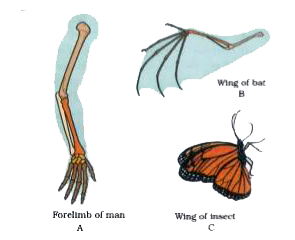
Form one pair of homologous organs and one pair of analogous organs from the diagrams given below:03:26View SolutionCarefully observe the given diagram/ chart and answer the questions related with it:
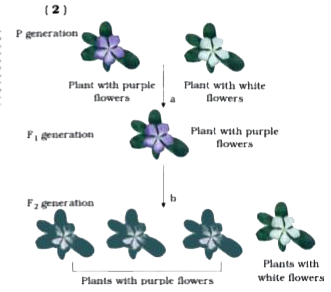
In the given figure state suitable word in place of a and b for the type of reproduction.02:51View SolutionCarefully observe the given diagram/ chart and answer the questions related with it:
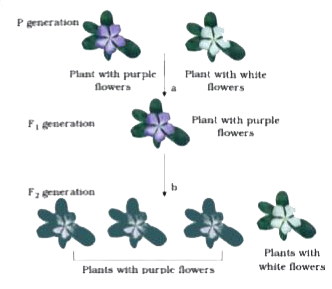
Which character' is a dominant one ? How would you decide that it is a dominant character ?02:46View SolutionCarefully observe the given diagram/ chart and answer the questions related with it:
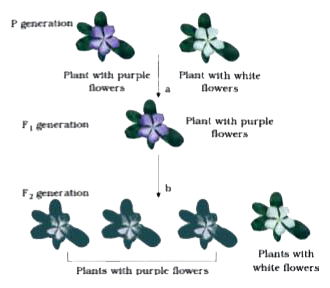
What is the ratio of expression of dominant and recessive traits in the `F_(2)` generation?02:35View SolutionIdentify the fossils a, b and c in the given diagrams:
 02:07View Solution
02:07View SolutionMendel's experiment to study inheritance in the pea plant (Pisum sativum) is shown in the following diagram. Study the diagram carefully and complete the empty boxes by filling them properly.
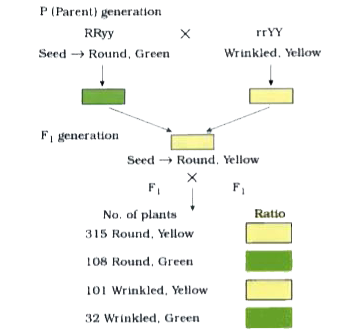 03:15View Solution
03:15View Solution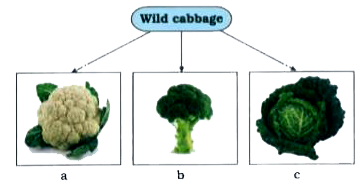
Name the diagrams a, b and c and from which part of the wild cabbage are they obtained ? Which method is used for obtaining these ?03:20View Solution
ADDITIONAL QUESTIONS AND ANSWERS questions and complete solutions for chapter HEREDITY AND EVOLUTION of KUMAR PRAKASHAN of Class 10
All Exercises from KUMAR PRAKASHAN Class 10 BIOLOGY HEREDITY AND EVOLUTION
- ADDITIONAL QUESTIONS AND ANSWERS
- OBJECTIVE QUESTIONS AND ANSWERS
- OBJECTIVE QUESTIONS AND ANSWERS (Answer as directed : (Miscellaneous))
- OBJECTIVE QUESTIONS AND ANSWERS (Answer the following questions in short : )
- OBJECTIVE QUESTIONS AND ANSWERS (Fill in the blanks: )
- OBJECTIVE QUESTIONS AND ANSWERS (Graph-diagram based questions : )
- OBJECTIVE QUESTIONS AND ANSWERS (Select the correct alternative from those given below each question: )
- OBJECTIVE QUESTIONS AND ANSWERS (State whether the following statements are true or false : )
- PRACTICAL SKILL BASED QUESTIONS WITH ANSWERS
- QUESTIONS AND ANSWERS
- TEXTUAL EXERCISE
- VALUE BASED QUESTIONS WITH ANSWERS
